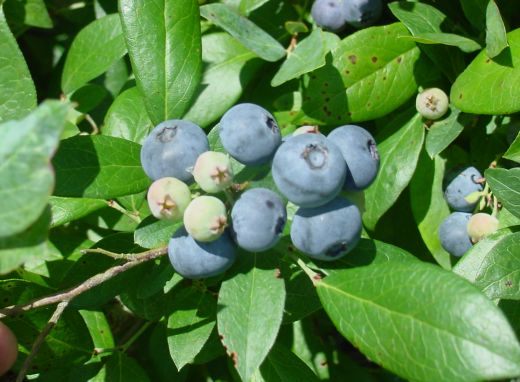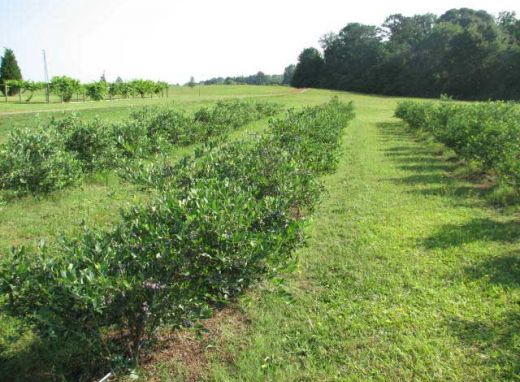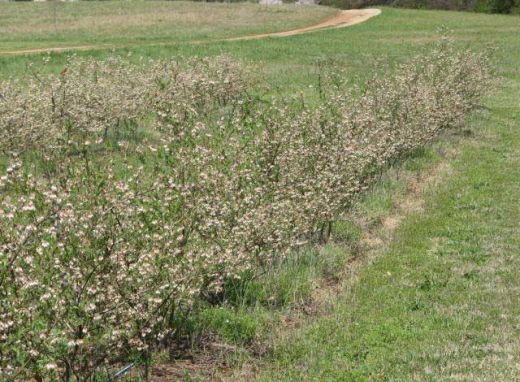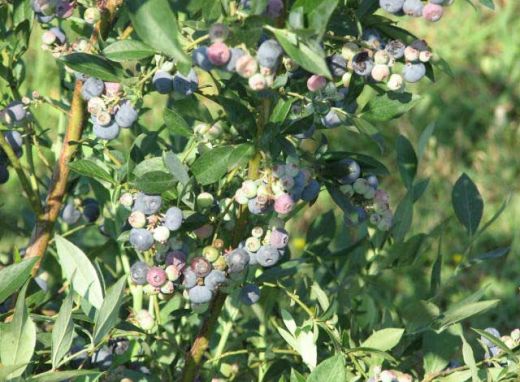At a Glance
Vernon is an early season rabbiteye blueberry with favorable fruit attributes, large berry size, high yields and excellent plant vigor. Although plants of Vernon often flower seven days after Climax in south Georgia, they can flower earlier than desired in some years when tempatures warm up quickly. However, Vernon fruit ripens early for a rabbiteye, usually several days ahead of Climax and Premier.
Fruit
Vernon produces a high yield of large fruit of excellent quality. Berries are large and have excellent firmness, color, flavor and dry scars, which contribute to good shelf life. Both flavor and berry size improve as fruit hang ripe for an extra few days.
Cultivation
Vernon is recommended where rabbiteye blueberries are grown successfully as an early ripening cultivar to replace Climax and/or Premier. Vernon’s estimated chill hour requirement is 450 hours or less below 45 degrees F. Vernon has shown to be suitable for mechanical harvesting.
Care should be used in fertilizing Vernon, as over-fertilization—especially of nitrogen—can promote excess vegetation that does not readily contribute to yield. The variety should be planted with other rabbiteye blueberries such as Alapaha for cross pollination.
Development
Developed by D. Scott NeSmith of the University of Georgia, Vernon is a joint 2004 release by the University of Georgia College of Agricultural and Environmental Sciences and the U.S. Department of Agriculture/Agricultural Research Service. This protected blueberry variety can be sold only by individuals licensed by the University of Georgia Research Foundation (UGARF) and Georgia Seed Development (GSD). USPP 18,291.
Breeder

D. Scott NeSmith
Dr. D. Scott NeSmith’s blueberry research program at the University of Georgia emphasizes new variety development as well as cultural management of blueberries for the southeastern United States.
Since taking over the UGA blueberry breeding program in 1998, Dr. NeSmith has released and patented 10 new commercial blueberry varieties and two ornamental blueberry varieties. His breeding program is now considered one of the most active low- to-mid chill blueberry programs in the world. He joined UGA in 1990.
Dr. NeSmith has expanded UGA’s program globally through collaborative projects throughout the U.S. and many other countries including South Africa, Argentina, Chile, Uruguay, Japan, Europe, Morocco, Australia, New Zealand, South Korea, Peru, and Mexico. Much of his cultural management research has been with growth regulators in blueberries. He also conducts experiments on plant establishment, pollination, and post-harvest quality.
Dr. NeSmith is a member of the American Society for Horticultural Sciences (ASHS) and the International Society for Horticultural Sciences. He is a past President of the Southern Region ASHS and has served as an Associate Editor for the ASHS journal, HortScience.
Dr. NeSmith has received the D.W. Brooks Excellence in Research Award from UGA and in 2011 was selected as a Fellow of the American Society for Horticultural Sciences. He has published more than 250 research papers, including more than 97 in refereed journals, and has received two awards for outstanding publications.
He graduated from the University of Georgia with B.S. and M.S. degrees. He obtained his Ph.D. from Michigan State University.
Affiliations
- Department of Horticulture
- University of Georgia, Griffin Campus




